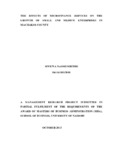| dc.contributor.author | Mwewa, Naomi Mbithe | |
| dc.date.accessioned | 2018-06-28T14:58:49Z | |
| dc.date.available | 2018-06-28T14:58:49Z | |
| dc.date.issued | 2013-10 | |
| dc.identifier.uri | http://ir.mksu-e.ac.ke/handle/123456780/222 | |
| dc.description | A MANAGEMENT RESEARCH PROJECT SUBMITTED IN
PARTIAL FULFILMENT OF THE REQUIREMENTS OF THE
AWARD OF MASTERS OF BUSINESS ADMINSTRATION (MBA),
SCHOOL OF BUSINESS, UNIVERSITY OF NAIROBI | en_US |
| dc.description.abstract | The Small and Medium Enterprise (SME) sector has continued to play an important role
in Kenyan Economy. The sector’s contribution to the Gross Domestic Product (GDP)
increased from 13.8% in 1993 to over 18% in 1999. The Economic survey 2012
estimated that the contribution to the GDP by this sector currently stands at over 25%. It
is the objective of every entrepreneur to grow their businesses into large enterprises. To
achieve this, most of the entrepreneurs make use of microfinance services. Many studies
have been done in Kenya on SMEs and how they are influenced by microfinance services
but none had focused on the effects of microfinance services on the growth of the SMEs.
The purpose of this study was to find out the effects of microfinance services on the
growth of Small and Medium Enterprises in Machakos County. A quantitative descriptive
design was used to study 8 types of business categories in Machakos County. Structured
questionnaire was used to collect data from 100 businesses. The sample of 100 businesses
from a list of 5311 was taken as a representative population in the county. The study was
on dependent and independent relationship. A moderate multiple regression analysis was
used. A multivariate regression model was applied to determine the relative importance
of each of the three variables; microcredit, micro insurance and training, with respect to
the effects of microfinance services on the growth of SMEs. The regression analysis
conducted established that two of the independent variables have a positive correlation
with the dependent variable. Micro credit and training contribute positively to the sales
growth while micro insurance affects growth negatively. The ANOVA analysis was
intended to investigate whether the variation in the independent variables explains the
observed variance in the outcome – in this study the annual growth in turnover. ANOVA
findings in this study showed that there was correlation between the predictor variables
(Microcredit, Micro insurance and Training provided by MFIs) and response variable
(Annual growth in turnover) since P- value of 0.011 is less than 0.05. This indicated that
there was a strong positive relationship between the study variables. | en_US |
| dc.language.iso | en_US | en_US |
| dc.subject | Micro and Small Enterprise | en_US |
| dc.subject | Large Scale Enterprises | en_US |
| dc.subject | Small and Medium Enterprises | en_US |
| dc.title | The Effects of Microfinance Services on the Growth of Small and Medium Enterprises in Machakos County | en_US |
| dc.type | Thesis | en_US |

